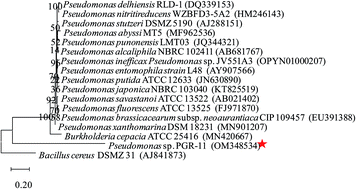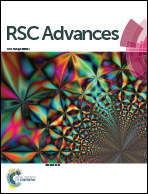Unraveling the potential of pesticide-tolerant Pseudomonas sp. augmenting biological and physiological attributes of Vigna radiata (L.) under pesticide stress†
Abstract
In the agricultural domain, chemical pesticides are repetitively and harshly used to kill harmful pests, but they often pose a serious threat to microbial diversity, soil fertility and agricultural output. To deal with these problems, pesticide-tolerant plant growth promoting (PGP) rhizobacterial strains are often used to combat pesticidal toxicity. Here, Pseudomonas sp. PGR-11 (accession no. OM348534), recovered from a Vigna radiata (L.) rhizosphere, produced various growth regulating (GR) substances, including indole-3-acetic acid (IAA; 82.5 ± 9.2 μg mL−1), enzyme 1-aminocyclopropane 1-carboxylate (ACC) deaminase (μM α-ketobutyrate mg−1 protein h−1), siderophores and ammonia. Strain PGR-11 grew well when cultured in growth medium with added metalaxyl (MTXL; 1200 μg mL−1), carbendazim (CBZM; 800 μg mL−1) and tebuconazole (TBZL; 1600 μg mL−1). Pseudomonas sp. synthesized PGP substances even in the presence of increasing doses of pesticides. The phytotoxicity of the tested pesticides was assessed both in vitro and under pot-house conditions using a Vigna radiata (L.) crop. Increasing concentrations of chemical pesticides negatively impacted the growth, physiological and biochemical features. However, pesticide-tolerant Pseudomonas sp. relieved the toxicity and improved the biological attributes of the plant. Bio-inoculated plants showed significant enhancement in germination attributes, dry biomass, symbiotic features and yield features when compared to un-inoculated ones. Furthermore, with 100 μg metalaxyl kg−1 soil, strain PGR-11 increased the chl-a, chl-b, total chlorophyll, carotenoids, SPAD index, photosystem efficiency (Fv/Fm), PSII quantum yield (FPSII), photochemical quenching (qP) and non-photochemical quenching (NpQ) content by 12, 19, 16, 27, 34, 41, 26, 29 and 33%, respectively, over un-inoculated but pesticide-treated plants. Additionally, inoculation of Pseudomonas sp. with 100 μg tebuconazole kg−1 soil caused a significant (p ≤ 0.05) enhancement in transpiration rate (E), stomatal conductance (gs), photosynthetic rate (PN), vapor pressure deficit (kPa) and internal CO2 concentration (Ci) of 19, 26, 23, 28 and 34%, respectively. Conclusively, the power to tolerate abnormally high pesticide concentration, the capacity to produce/secrete PGP substances even in a pesticide-stressed medium and the potential for improving/increasing the growth and physiology of plants by pesticide detoxification makes Pseudomonas sp. PGR-11 a fascinating choice for augmenting the productivity of V. radiata (L.) even in pesticide-stressed soils. The current findings will be helpful for exploring pesticide-tolerant ACC-deaminase-positive microbial strains as gifted entities for the environmental bioremediation of pesticides.


 Please wait while we load your content...
Please wait while we load your content...